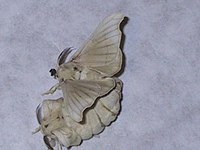
Photo from wikipedia
Spiders produce multiple silks with different physical properties that allow them to occupy a diverse range of ecological niches, including the underwater environment. Despite this functional diversity, past molecular analyses… Click to show full abstract
Spiders produce multiple silks with different physical properties that allow them to occupy a diverse range of ecological niches, including the underwater environment. Despite this functional diversity, past molecular analyses show a high degree of amino acid sequence similarity between C-terminal regions of silk genes that appear to be independent of the physical properties of the resulting silks; instead, this domain is crucial to the formation of silk fibers. Here, we present an analysis of the C-terminal domain of all known types of spider silk and include silk sequences from the spider Argyroneta aquatica, which spins the majority of its silk underwater. Our work indicates that spiders have retained a highly conserved mechanism of silk assembly, despite the extraordinary diversification of species, silk types and applications of silk over 350 million years. Sequence analysis of the silk C-terminal domain across the entire gene family shows the conservation of two uncommon amino acids that are implicated in the formation of a salt bridge, a functional bond essential to protein assembly. This conservation extends to the novel sequences isolated from A. aquatica. This finding is relevant to research regarding the artificial synthesis of spider silk, suggesting that synthesis of all silk types will be possible using a single process.
Journal Title: Heredity
Year Published: 2018
Link to full text (if available)
Share on Social Media: Sign Up to like & get
recommendations!